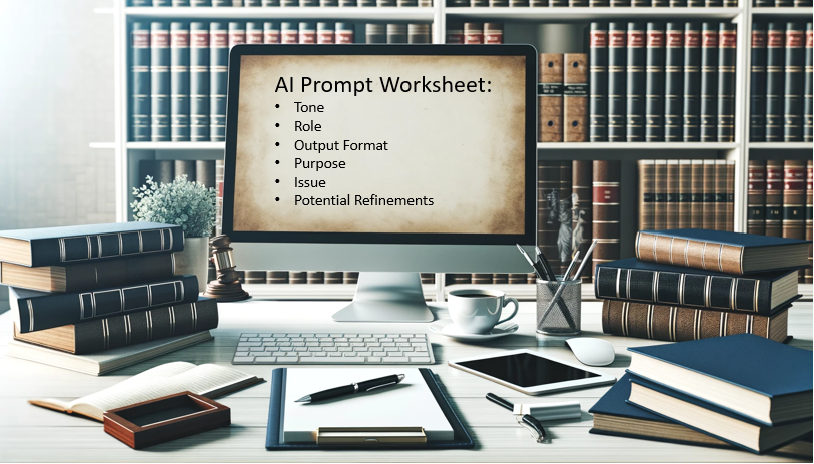I spent the first week of January attending the American Association of Law Schools’ Annual Meeting in Washington D.C. I was really impressed with all of the thoughtful AI sessions, including two at which I participated as a panelist. The rooms were packed beyond capacity for each AI session that I attended, which underscored the growing interest in AI in the legal academy. Many people attended in order to start their education. The overwhelming interest at the conference made my decision clear: it is time to launch my AI prompt worksheets to the world, addressing the need I observed there. While AALS convinced me to release the worksheets, the worksheets themselves were created for an upcoming presentation at ABA TECHSHOW 2024, How to Actually Use AI in Your Legal Practice, at which Greg Siskind and I will be discussing practical tips for generative AI usage.

Background: Good Habits – Research Planning
Law librarians have been encouraging law students to create a research plan before they start their research for decades. The plan form varies by school and/or librarian, but it usually requires the researcher to answer questions on the following topics:
- Issue Identification
- Jurisdiction
- Facts
- Key words/Terms of Art
- Resource Selection
Once the questions are answered, the plan has the researcher write out some test searches. The plan evolves as the research progresses. The more experienced the researcher, the less formal the plan often is, but even the most experienced researcher retrieves better results if they pause to consider what they know currently and what they need in the results. After all, garbage in, garbage out (GIGO). In other words, the quality of our input affects the quality of the output. This is especially true when billable hours come into play, and you cannot bill for excess time due to poor research skills.
Continuing the Good Habits with Generative AI
GIGO applies just as much to generative AI. I quickly noticed that my AI results are much better when I stop and think them through, providing a high level of detail and a good explanation of what I want the AI system to produce. So, good law librarian that I am, I created a new form of plan for those who are learning to draft a prompt. Thus, I give you my AI prompt worksheets.
AI Prompt Worksheet – General
The first worksheet that I created is geared towards general generative AI systems like ChatGPT, Claude 2, Bing Chat/Copilot, and Bard. The worksheet makes the prompter think through the following topics:
- Tone of Output
- Role
- Output Format
- Purpose
- Issue
- Potential Refinements (may be added later as the plan evolves)
So that you can easily keep track of your prompts, the Worksheet also requests some metadata about your prompt, including project name, date, and AI system used. The final question lets the prompter decide if this prompt worked for them.

AI Prompt Worksheet – Legal
For the second worksheet, I wanted to draft something that works well with legal AI systems. Based on the systems that I have received access to, such as Lexis AI and LawDroid Copilot, and the systems that I have seen demonstrated, I cut down some of the fields. Most of the systems are building a guided AI prompting experience, so they will ask you for the jurisdiction, for instance. They may also allow you to select a specific type of output, such as a legal memo or contract clause. This means less need for an extensive number of fields in the worksheet. In fact, when I ran the worksheet past a vLex representative, I was told it was not needed at all because they had made the guided prompt that easy.
Librarian that I am, however, I still feel that planning before you prompt is preferred. Reasons for this preference include: the high cost of the current generative AI searches, the desire for efficient and effective results, knowledge that an attorney’s time is literally worth money, and the desire for a happy partner and client.
The legal worksheet trims the fields down to role, output (format and jurisdiction), issue, and refinement instructions. This provides enough room to flesh out your prompt without overlapping the guided prompt fields too much.
General Comments Regarding the Worksheets
With both worksheets, the key is to give a good, detailed description of what you need. Think about it like explaining what you need to a first-year law student – the more detail you give, the more likely you are to get something useable. The worksheets provide examples of the level of detail recommended, and you will find links to the results in the footnotes of the forms.
In addition to helping perfect your prompt with some pre-planning, these worksheets should be useful for creating your very own prompt library.
Feedback Wanted!

Please feel free to use the worksheets (just don’t sell them or otherwise profit off of them! Ask if you want to make a derivative of them). If you do use them, please let me know what you think in the comments or via email. How have they assisted (or not) with improving your prompting skills? Are there fields you would like to see added/removed? I will be updating and releasing new versions as I go. If you are looking for the most recent versions of the worksheets, I will post them at: https://law-capital.libguides.com/Jennys_AI_Resources/AI_Prompt_Worksheets
